By AMELIA T. REIHELD
It’s a beautiful view from the top of Jockey’s Ridge, the towering sand dunes on North Carolina’s Outer Banks. To the east, there are cheek-by-jowl beach cottages and then the expanse of the Atlantic Ocean, topped with whitecaps. To the west the Currituck Sound forms a swath of blue between dunes and the lavender shadow that is the rest of the United States. Between here and the sound, there are vast mountains and valleys of soft golden sand and scrubby dune vegetation.
Atop one of those massive sand dunes, I am stretched out prone on the 1902 Wright Glider. For real.
It looks a long way down to the bottom of that steep slope, and my ride seems far too delicate, a Rube Goldberg-ish contraption of thin strips of spruce and ash, its biplane wings formed with bias-sewn cotton muslin stretched over the ribs, secured with small knots of twine, and braced with crisscrossed strands of taut twisted wire. The whole thing is trembling in the stiff breeze.
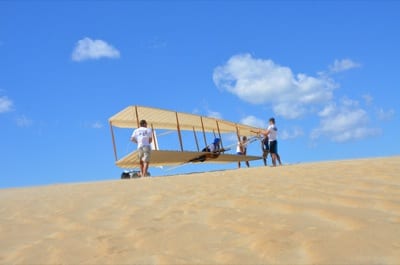
In the middle is a simple wooden cradle to lie down on, facing forward. By moving my hips from left to right, I can pull on cables that will warp the wings to control the direction of flight. My forearms rest on the spars for the canard wing out front, and my wrists will operate the elevator control bar. My ankles rest on a bar behind me. It’s really surprisingly comfortable. I am craning my neck to see over the canard, half-wondering, “What on earth am I doing here, anyway?”
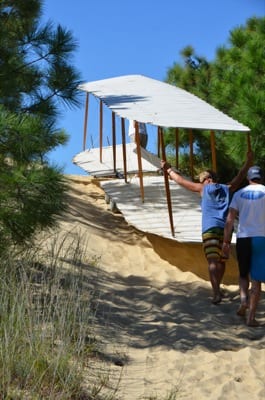 I happen to live in American History’s back garden in eastern North Carolina, just a half-hour Mooney ride from the aviator’s Mecca, First Flight Airport (FFA) at Kill Devil Hill. The Wright Brothers Memorial and the museum, with models, replicas, dioramas, photographs, news clippings and more, draw visitors from all over the nation, but what lured me here was an opportunity to actually fly that 1902 Wright Glider, just as Orville and Wilbur did, 100 years ago.
I happen to live in American History’s back garden in eastern North Carolina, just a half-hour Mooney ride from the aviator’s Mecca, First Flight Airport (FFA) at Kill Devil Hill. The Wright Brothers Memorial and the museum, with models, replicas, dioramas, photographs, news clippings and more, draw visitors from all over the nation, but what lured me here was an opportunity to actually fly that 1902 Wright Glider, just as Orville and Wilbur did, 100 years ago.
Built by aviation historian Ken Hyde at The Wright Experience Foundation, this glider was used to train pilots to fly the 1903 Wright Flyer replica for the First Flight centennial celebration nearly a decade ago. Because there was no surviving glider — only a small piece of one wingtip — the builders resorted to reverse engineering based on old photographs and Army Corps of Engineers drawings from the 1930s. It was this craft that gave the Wrights the assurance that it would be possible for humans to fly, not like birds, but like engineers. Painstakingly, step by step, the Wrights tweaked the design, and time after time, were towed aloft by their coworkers, to figure out how to make their craft controllable. With this model, and its new wing design, for the first time ever, the pilot could coordinate the flight’s direction and pitch.
I have two classmates this day, for whom the stars, the winds, and Mother Gaia herself, have aligned, giving us perfect weather for glider-flying. One of them, Dale Mallett, a former private pilot and lifelong aviation enthusiast, is celebrating his 60th birthday with what he calls “the most awesome gift ever.” He has looked forward to this day for months, and has studied every scrap of Wright history he could get his hands on. With his wealth of detailed information and historic footnotes, he marvels at the mathematical beauty and the careful construction of this simple machine. “Look at that waxed string there reinforcing the framework,” he points out.
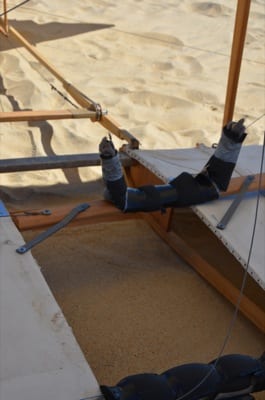 Our instructor, Bruce Weaver, recreation manager at Kitty Hawk Kites, which offers the glider experience, quips, “That is the 1902 version of duct tape.”
Our instructor, Bruce Weaver, recreation manager at Kitty Hawk Kites, which offers the glider experience, quips, “That is the 1902 version of duct tape.”
My other classmate, Pete Bastien, has come to this adventure from another side of the aeronautical spectrum, accustomed as he is to the raw power and spectacular performance of a Pitts Special. His eyes, too, are alight at the chance to relive history, and his grin-muscles are as taut as mine.
After signing away several formidable pages of legal rights, ours and those of our heirs and assigns in perpetuity, we follow the glider-toting guys from Kitty Hawk Kites’ Hang-Gliding School through a maritime woodland path, up to those famous dunes.
“Nothing to it,” Weaver, the veteran of some 30 flights, assures us. Once the preliminaries are completed, assembling the glider’s components, preflight inspection, and beautiful demonstration ride by one of the Kitty Hawk hang-glider instructors, our own moments of truth are at hand.
“Ladies first,” the gentlemen agree.
Gulp…soon enough, there I am, a grandma who has obviously taken leave of her senses, helmeted and harnessed, with a sturdy lad on each wing, and one in front, all holding long tethering lines. They lift me up, glider and all, and nod their readiness at Bruce Weaver’s inquiry. As I wiggle my hips from side to side, and test the elevator control bar, Weaver kicks at the sand to confirm the wind direction.
“Steer toward that second telephone pole, and don’t look down,” he shouts. “Clear! Let’s do it!” And then, oh my, they’re all now running down that steep hill pulling me along with them. The 18-knot northeasterly breeze hoists me aloft just like an oversized kite, and easy-does-it, I am floating, floating, flying!
For perhaps seven unbelievable seconds, I understand exactly what it was that those visionaries from Ohio were after. Much too soon, gravity wins out over lift. Faced with the sand rising inexorably toward me, I cock my wrists upward on the canard’s elevator control for a landing flare into Kitty Hawk’s soft sand. Scooosh. Oh, WOW! Not scary at all, as it turns out. We trudge up the dune, excited to go do it again.
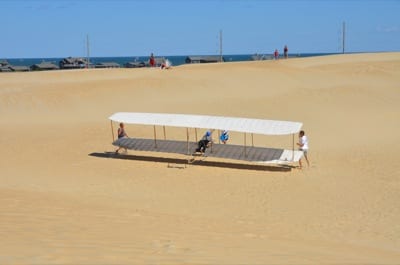 It’s easy to see why the Wright brothers added motors to their next model. Those few seconds of wind in the face and the almost weightless grace are pure exhilaration, and I don’t want the ride to be over.
It’s easy to see why the Wright brothers added motors to their next model. Those few seconds of wind in the face and the almost weightless grace are pure exhilaration, and I don’t want the ride to be over.
When conditions are right, as they are for much of the “off-season” from September to May, $349 buys five glorious tethered rides downhill, five hikes back up the dune, and especially amazing memories for a flying or history enthusiast.
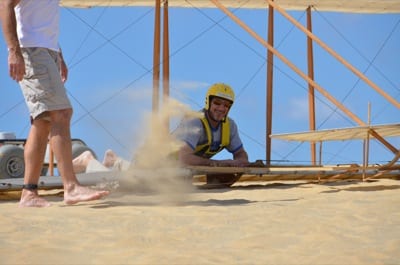 Although many of the glider-riders are pilots, the only requirement is that customers must be able to walk in soft sand from the bottom of the dune back up to the top. The day includes the briefing, some history, some lovely scenery, the glider rides, and a certificate suitable for framing. It takes about four hours, which leaves plenty of time to explore the Wright Brothers National Monument museum, for a complete First Flight experience. The Wright Glider appointment is contingent on fine weather and steady wind between 15 and 20 knots.
Although many of the glider-riders are pilots, the only requirement is that customers must be able to walk in soft sand from the bottom of the dune back up to the top. The day includes the briefing, some history, some lovely scenery, the glider rides, and a certificate suitable for framing. It takes about four hours, which leaves plenty of time to explore the Wright Brothers National Monument museum, for a complete First Flight experience. The Wright Glider appointment is contingent on fine weather and steady wind between 15 and 20 knots.
For more information, those interested in getting the best possible close-up of aviation’s earliest history, can call Kitty Hawk Kites, 877-FLY-THIS, or Bruce Weaver at 252-441-2426. More information is available at the company’s website
Especially in the less hectic, but idyllic months that aren’t high summer, KHK personnel will be happy to meet fly-in customers at FFA, First Flight Airport, at the Wright Brothers National Monument, for the three-mile ride down to Jockey’s Ridge State Park.

Hi Amelia,
Great article! Nice photos! Makes me feel like flyin’ . . . again.
Dale
Nicely done, Amelia! Thanks to your compelling narrative, I could smell and feel the sea breeze, enjoy the moment of lift off and ride along with you.